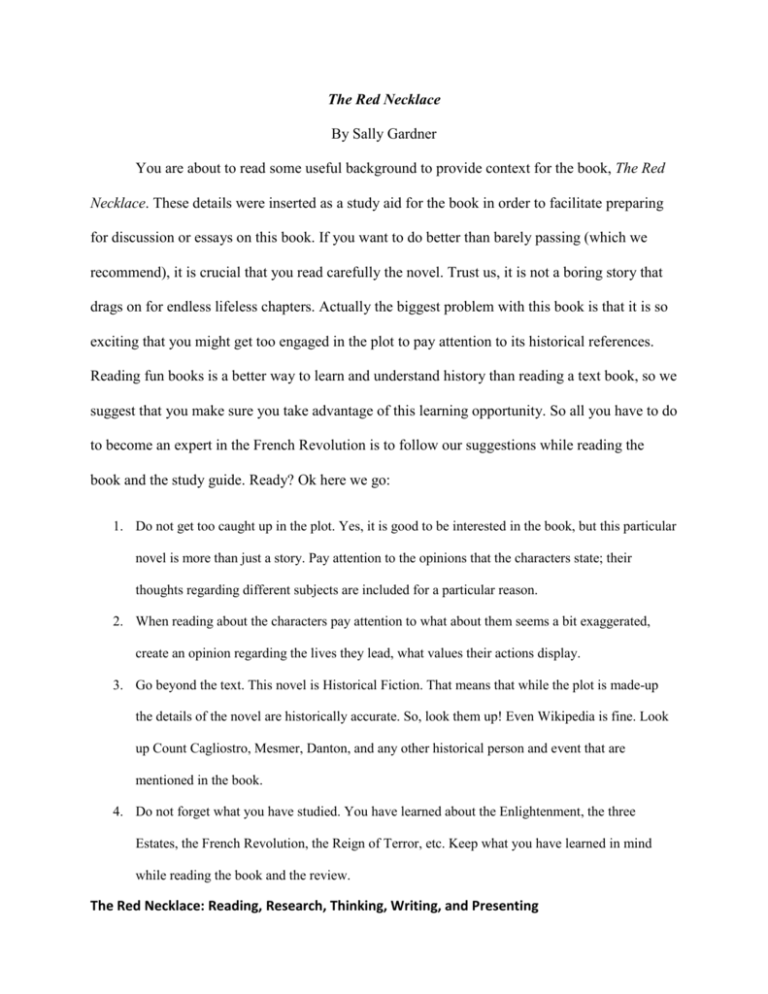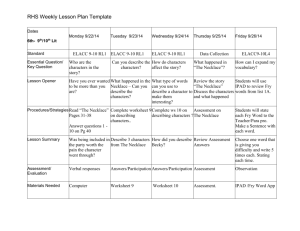The Red Necklace 2
advertisement

The Red Necklace By Sally Gardner You are about to read some useful background to provide context for the book, The Red Necklace. These details were inserted as a study aid for the book in order to facilitate preparing for discussion or essays on this book. If you want to do better than barely passing (which we recommend), it is crucial that you read carefully the novel. Trust us, it is not a boring story that drags on for endless lifeless chapters. Actually the biggest problem with this book is that it is so exciting that you might get too engaged in the plot to pay attention to its historical references. Reading fun books is a better way to learn and understand history than reading a text book, so we suggest that you make sure you take advantage of this learning opportunity. So all you have to do to become an expert in the French Revolution is to follow our suggestions while reading the book and the study guide. Ready? Ok here we go: 1. Do not get too caught up in the plot. Yes, it is good to be interested in the book, but this particular novel is more than just a story. Pay attention to the opinions that the characters state; their thoughts regarding different subjects are included for a particular reason. 2. When reading about the characters pay attention to what about them seems a bit exaggerated, create an opinion regarding the lives they lead, what values their actions display. 3. Go beyond the text. This novel is Historical Fiction. That means that while the plot is made-up the details of the novel are historically accurate. So, look them up! Even Wikipedia is fine. Look up Count Cagliostro, Mesmer, Danton, and any other historical person and event that are mentioned in the book. 4. Do not forget what you have studied. You have learned about the Enlightenment, the three Estates, the French Revolution, the Reign of Terror, etc. Keep what you have learned in mind while reading the book and the review. The Red Necklace: Reading, Research, Thinking, Writing, and Presenting The Red Necklace Pre-reading Guide: Historical Connections The Red Necklace’s Count Kalliovski is modeled after Alessandro Cagliostro. Cagliostro grew up in Sicily and travelled across Europe. He studied alchemy, Kaballah and magic. He lived double lives under multiple aliases. He worked as a secretary, forger of fake documents, and sold Egyptian amulets. He was imprisoned in the Bastille for being involved in Marie Antoinette’s Affair of the Document Necklace. Like Count Kalliovski, his ventures are shrouded in mystery and suspicion. Toward the end of his life, he was accused of being a freemason and was sentenced to death. The Pope commuted his sentence, and soon died in prison Franz Mesmer is a German physician who had an interest in astronomy and theorized that were was a natural energy between animate and inanimate objects called magnétisme animal, or animal magnetism, and other spiritual forces. This was called mesmerism and is considered to be a form of vitalism which refers to the movement of life “energy” through the body; although, Mesmer initially uses it to attempt the treatment of sick people. In The Red Necklace this theory is apparent in the “magic” that Yann, Têtu, and Count Kalliovski use. Their ability to move objects with the threads of light refers back to the idea of mesmerism and was used by Sally Gardner, the author as a real idea tied in with a fictional story. It is important to be aware of this to further understand the story since the Revolution was originally brought about by the Enlightenment; yet, the streets of Paris are filled with citizens amazed at the magic performed by Yann and Têtu. This contrasts the life in the Revolution with Enlightenment ideas of freedom and liberty, with enthralling ideas of the supernatural and magic. The Red Necklace: Reading, Research, Thinking, Writing, and Presenting 1. Based on the events and descriptions provided in the novel, describe the life and status of the Roma people in 18th Century Paris. How could the experience of the Roma communities in nonParisian France have been different? Why? Take in consideration that the population in rural France would have been more homogeneous than that of Paris. Consider traditional Roma culture, i.e., occupations, behaviors, habits. 2. Give examples from the novel that demonstrate the gulf between the Second Estate and the Third Estate? Who are the members of each and what proportion of the population do they represent? How does the novel characterize the lifestyle of the aristocracy? Given the values and the actions they display in the novel, why does the nobility seem unable to lead the country? 3. What were three different ways in which the French aristocrats reacted to the Revolution? Give examples from the book. What were the risks and benefits of each? 4. How do Mr. and Mrs. Laxton reflect the ideals of the Enlightenment? Take into consideration their attitude towards education, willingness to host a gypsy boy, and acknowledgement of the existence of childhood. 5. Taking in consideration Sido, Mrs. Laxton, and the French women who attacked Versailles, describe the roles, society’s expectations, and powers of women in France and England during the 18th Century. Keep in mind their different social status. 6. Give some arguments against the French Revolution and the execution of Louis XVI and Marie Antoinette. Support your arguments with instances from the book. 7. What events led to the September Massacres? What were the reasons that Sido was declared innocent? How much did her gender have to do with the sentence? 8. Discuss this claim: The Terror helped to solidify the Revolution. Take into consideration the end of the book, but do not limit your answer to the novel. “After today there will, I believe, be a flood of desperate people who will risk everything to escape from France. I’m not just talking of nobles. I mean anyone who supplied goods to the aristocracy, anyone who looks intelligent enough to ask the unanswerable question: What happened to this great and glorious idea?” (368) The Red Necklace: Reading, Research, Thinking, Writing, and Presenting






